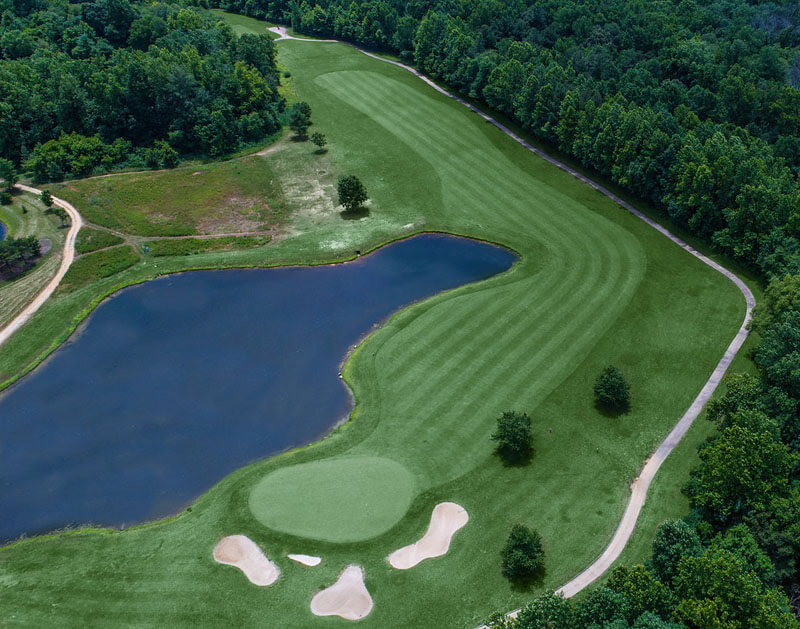Dogleg holes are an essential element of any golf course, testing the skills and strategic thinking of players of all levels. These challenging holes require precision and careful consideration to navigate, as golfers must navigate their ball around a corner or bend in the course. Regardless, dogleg holes offer an exciting and unique challenge for golfers, which is why they continue to be a beloved and essential feature of golf courses worldwide.
What Is A Dogleg Hole In Golf?

Dogleg holes in golf courses are designed to challenge the skills of even the most experienced golfer. The bent shape of such holes, like the hind leg of a dog, requires players to aim carefully in order to find a suitable spot on the fairway with which to get around the bend.
Successful navigation of a dogleg hole often requires careful consideration of risk versus reward. Even in cases where water is a factor, skilled golfers can make choices that determine the outcome of their game. Dogleg holes are strategic challenges that can make or break an entire round of golf.
Types Of Doglegs – Left, Right, And Double Doglegs
LEFT DOGLEGS
As any avid golfer will tell you, dogleg left holes can be a challenge. Although it may be tempting to take a shorter route by cutting over the left side of the dogleg, this strategy rarely pays off.
Typically, the left side of the hole is fraught with obstacles, such as trees, bunkers and deep rough. In order to successfully navigate a dogleg left, you need to plan your shots carefully and stay focused throughout the hole.
RIGHT DOGLEGS
As the name implies, a dogleg right features a sharp right turn after the tee shot, making it difficult to navigate. The obstacles that typically line the right side of the hole, such as bunkers, trees, and deep rough, can prove to be major obstacles for golfers who try to cut the hole by shooting over the short side of the dogleg.
DOUBLE DOGLEGS
Double doglegs are one of the most difficult challenges a golfer can face. The two sharp turns in the fairway that constitute a double dogleg require the player to carefully plan and strategize each shot.
The obstacles that are typically placed on either side of a double dogleg make the hole twice as difficult to navigate, as golfers must decide which side of the dogleg they want to tackle. A successful strategy can make the difference between a par or birdie and a bogey.
Strategy For Playing Dogleg Holes

Navigating dogleg holes can be tricky, but there are some strategies that golfers should consider when tackling these challenging holes.
First and foremost, it is important to take out all of the guesswork by mapping out your shot before you head to the tee box. Knowing where your ball needs to land in order to get around the dogleg can help you choose the right club for each shot.
It is also important to take into account any hazards that may be present on either side of the hole, such as trees, bunkers, and deep rough. Knowing these obstacles ahead of time can help you plan your shots accordingly.
But if you possess the ability to drive the ball farther than the distance to the corner, then you may want to attempt a draw or fade around the turn. Alternatively, if the conditions and yardages permit, you could try to cut the corner and land your ball on the portion of the fairway after the bend. However, the dogleg may limit your choices, and you may be forced to play the ball to the corner yardage with a shorter club.
Finally, it is important to be patient. Dogleg holes can be frustrating, but taking your time will almost always pay off in the end.
How Is A Dogleg Measured?
Dogleg holes on a golf course are measured in a specific way to ensure their accuracy. Rather than measuring from the tee to the green in a straight line, these holes are measured along their most likely playing route.
This typically involves measuring from the teeing ground to the corner of the dogleg and from the corner to the green, following the middle of the fairway. However, it’s important to note that this measurement is a sight-line measurement, not an along-the-ground measurement that would take into account the contours of the fairway.
Nowadays, survey equipment and GPS are typically used for this process, ensuring precise and reliable measurements every time.
Famous Dogleg Holes In Golf History

Over the years, there have been some truly iconic dogleg holes in golf that have provided some of the most exciting and memorable moments in the sport’s history.
Three of the most famous doglegs are the 13th at Augusta National, the 8th at Pebble Beach and the second hole at Highland Links. These three historic holes have witnessed many thrilling shots over their long history, and are a testament to the difficulty that doglegs can present.
The 13th hole at Augusta National is one of the most iconic doglegs in golf history. The sharp turn from the tee to the green presents a unique challenge for golfers, as they must decide whether to go with a long drive around the bend or attempt to cut it off and play directly over the corner.
Another iconic dogleg is the 8th hole at Pebble Beach. This par 6th offers sweeping views of the Pacific and requires golfers to decide whether they want to try to cut off the corner or play it safe and take the long route around it.
Conclusion
Dogleg holes can be a challenge for even the most experienced golfers. However, with some careful planning and an understanding of how they are measured, you will be better equipped to manage these obstacles when you hit the green. Taking into account yardage, wind conditions, and other factors will help you make informed decisions about your shot selection and strategy. With a little practice and patience, you can turn any dogleg into an opportunity to improve your game.


